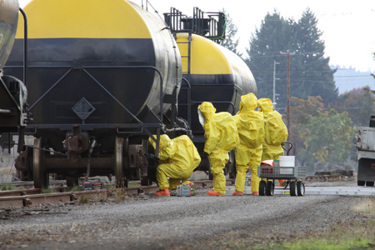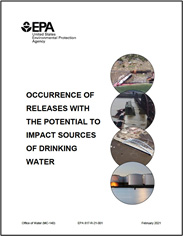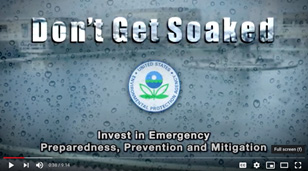Is Your Source Water In Danger? Invest In An Ounce Of Prevention


Despite all of life’s adages about the value of preparation (an ounce of prevention…, a stich in time…, failing to plan…), it’s easy for long-range source-water-security planning to be deferred because ‘there’s just not enough time or funding to do it right now.’ But for decision-makers at drinking-water utilities, the consequences of such a missed opportunity or deferred expense can be crushing to a local community and its economy. With the stakes of compromised water quality being so high, here are some helpful insights and incentives on why and how to improve that planning sooner rather than later.
This recent report from the U.S. EPA’s Water Security Division of the Office of Ground Water and Drinking Water (Figure 1) documents the impacts of chemical spills on drinking water sources, with an eye toward helping water utilities refine their risk-and-resilience assessments as required by America’s Water Infrastructure Act (AWIA) of 2018. Below are some highlights from that document and ways that municipal water suppliers can take practical steps to ensure their resiliency in the face of worst-case scenarios.

Source: EPA Report 817-R-21-001
Figure 1. According to the EPA, “This document is intended for use by the drinking water sector to better understand the risk of potential releases into sources of drinking water. It may provide information useful for conducting Risk and Resilience Assessments, as required under America’s Water Infrastructure Act (AWIA) of 2018.”
“That Couldn’t Happen To Us”: Recognizing The Realm Of Possibilities
Any resilience plan needs to take into account the possibility of catastrophic events, which are different for each water-utility surface-water or groundwater intake relative to the nature of threats in the local area. The EPA report outlines a series of large-scale release events (> 2,000 gallons) that occurred in the calendar years from 2010 through 2019 and covered a wide range of contaminating materials. Those major events, however, represented just a fraction of the 281,141 total oil and chemical releases reported to the National Response Center (NRC) over the 10-year period. State, county, municipal, and tribal government agencies can access historical records of those releases in their local areas via the NRC homepage and they can request future real-time incident notifications for their area from the NRC.
“Releases occurred in all 50 states and D.C. with the highest density of releases near urban areas, industrial hubs, resource extraction hubs, and transportation corridors (including rivers used for cargo transport).”
Source: U.S. EPA Report, Occurrence Of Releases With
The Potential To Impact Sources Of Drinking Water
Major spills outlined in the report ranged from toxic chemicals to industrial byproducts to consumer products and even foods. The major impacts within the report came from coal combustion byproducts (i.e., fly ash), wastewater discharges, mine waste, alcohol, and crude petroleum/drilling fluids. Private enterprises were responsible for the majority of spills — by both the number of incidents and the volume of spills. Although there were a number of unknown/‘other’ causes for the spills, the most frequently documented causes were equipment failure, transportation accidents, and operator error.
Reviewing those major spills in the context of similar commercial, industrial, or transportation operations in a utility’s operating area can be a good start to calculating the odds of a specific local occurrence and developing action plans for those that represent the proportionally highest risk. It could also help in assessing the use of advance detection systems upstream of vulnerable water intakes in areas associated with known high risks (e.g., industrial chemical operations or congested transportation links such as rail yards or railroad bridges adjacent to water-supply sources).
Reasons And Resources To Refresh Risk Assessments And Recovery Plans
Because emergencies related to harmful chemical releases can be fast-developing events — depending on the locations of spills relative to drinking-water intakes — it is important to have detection or emergency notification plans in place well before an emergency strikes. That includes having all resources and responsibilities spelled out in advance in order to prevent an emerging threat from turning into a crippling event. This EPA video on Investing in Emergency Preparedness (Figure 2) touches on approaches that can be used to prepare for a variety of emergencies, including harmful chemical spills:
- Update the utility’s consequence-management plan, emergency-response plan, or continuity-of-operations plan to assure that all staff members know their responsibilities during a source-water contamination emergency.
- Prepare a memorandum of agreement with local mutual-aid-and-assistance networks (e.g., Water/Wastewater Agency Response Network [WARN])
- Participate in local-community emergency-response plans to be familiar with other available response partners for mutual aid.

Source: https://www.epa.gov/waterresilience/basics-water-resilience
Figure 2. This EPA video emphasizes the value of investing in emergency preparedness, prevention, and mitigation activities for source-water protection against catastrophes ranging from natural disasters to manmade chemical spills and other potential disruptions.
Since the passage of AWIA, Section 2018, water utilities should be familiar with all facets of the Emergency Planning and Community Right-to-Know Act (EPCRA). The overviews available in this EPCRA guide and these FAQs are good references. Also, the requirement for all community water systems serving more than 3,300 persons to develop or update their risk-and-resilience assessments is scheduled for June 30, 2021, with emergency response plans due by the end of 2021. Utilities that still need to conduct a drinking-water-utility risk assessment can take advantage of the web-enabled Vulnerability Self-Assessment Tool (VSAT Web) 2.0
In terms of identifying and reacting to potential threats to source-water quality, it can also pay to borrow from other EPA-recommended Drinking Water and Wastewater Resilience resources as well as the specific Risk Assessment and Emergency Response Plan requirements and assistance resources. Being familiar with the resources of the Water and Wastewater Laboratory Network can also help water utilities be better prepared to respond during contamination incidents.
